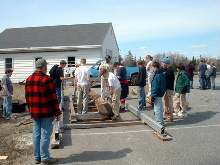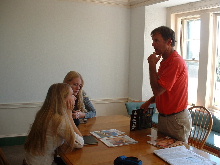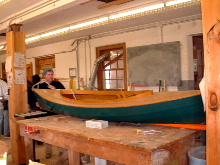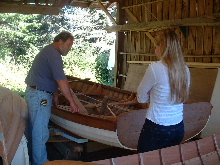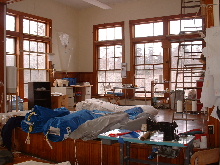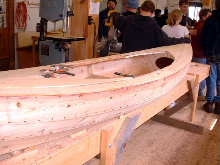Maine Boatbuilding Traditions
*Note: PDF transcripts for the starred people quoted below can be found at the bottom of the page.
During the winter of 2003 and 2004, Pauleena MacDougall interviewed boatbuilders in the town of Brooklin, Maine. The purpose of these interviews was to develop a sense of the current status of wooden boat building, but boat building using other materials was not excluded. Boat yard owners and boat yard workers were interviewed. The interviews revealed a thriving industry in the creation of recreational craft and in boat repair and restoration. Some of the discussion centered on the definition of a wooden boat: Is a wooden boat only a boat made from plank on frame construction or is a cold-moulded constructed boat a true wooden boat? Among boat builders the questions is somewhat controversial. In addition, many builders are using fiberglass for the hulls of their boats. The most significant revelation about Maine boatbuilding is that Maine boatbuilders are both plentiful and highly skilled. Maine built boats are in demand throughout the world, and the reputation of Maine’s builders continues to bring steady business. The builders I talked to have more than enough work, but could use additional skilled employees.
Maine has always been a boatbuilding place. The combination of expanses of good wood for building and an extensive coastline for shipping and fishing, set the stage for making Maine a vast shipyard. Before Europeans arrived on the Maine coast, Native people built craft of birch bark and wood that traversed both oceans and rivers. The first ship built in Maine by the English was a pinnace named the Virginia, a twenty-ton vessel that served her owners well by carrying tobacco and other goods to Great Britain until she was wrecked off the coast of Ireland at the age of twenty.

Maine built many of the great multi-masted schooners and later, steam vessels. Many smaller boats were also built for the inland waterways, like the bateau, the Rangeley boat and the wood and canvas canoe. For the ocean builders made galleys, shallops, ketches, pinks and snows, yawls, sloops, jiggers, brigs, barques and gundalows, as well as dinghies and peapods. When steel and fiberglass replaced wood and steam, and motors replaced sail, wooden boat building no longer supported Maine towns. A few smaller companies continued, a few builders passed on their tradition, but it wasn’t until the 1970s that a true revival of building wooden sailboats took place, mostly for tourism. Several schools in Maine, including the Woodenboat School in Brooklin, continue to teach the craft.
While boats are built the width and breadth of Maine, this study concentrated on one small community that claims itself “The boat building capital of the world.” Although it may seem a lofty title for such a small community (with a population of about 800 souls) nearly everyone in town has built, is building, or plans to build a boat, so perhaps “per capita” there is some truth to the idea. Boat building defines how the community thinks about itself. Several families build boats and have passed on the traditional knowledge of boat building for several generations. The idea of boat building has created an identity for the community. One way this identity is expressed is through an annual project at the junior high school to build a boat every year with the help of parents and boat builders from the community. This sense of community extends to the way builders work together, also. If one builder has too many orders or becomes ill, other builders will help him out.
“Yes, if one of us is overbooked then we’ll turn customers on to one of the other places, so we all get along pretty well and help each other out when we can.” –Eric Dow, Brooklin, Maine*
Brooklin is not the only boat building community in Maine (others are Beals’ Island, Mt. Desert Island, Boothbay Harbor, Portland, Bath and numerous more). However, the presence of the Woodenboat school and magazine brings yachtsmen to their town and thus brings business. Today’s builders are making boats for recreation. There are few builders making working boats of wood anymore.
“There are more wooden boats being built here than any other community in Maine, I’m sure, because there are more wooden boat builders here. I don’t know why Brooklin has become sort of the Mecca for wooden boat building particularly, other than probably WoodenBoat Magazine was here. It’s a strong tradition and its an interesting community. A lot of these guys have been working here for twenty years or more, and that’s fun and interesting. And there’s a lot of younger people coming up now, that are starting to take some real pride in being able to work with their hands and produce things that are aesthetically pleasing to them.” –Steve White, Brooklin Boatyard*
Boat building is acknowledged as a highly skilled art by the larger coastal community. About twelve years ago Fineas Sprague Jr. and Jon Johanson created a boat builders Hall of Fame at the annual Maine Boatbuilder’s Show to honor the best of the builders. One member of the hall of fame who made a large impact on the community was Joel White. Son of the writer E.B. White, Joel grew up in Brooklin around boats and builders and became a well-known boat designer.
“He started working as a lobsterman for a little while. And then got a job here at the boatyard and became partners with Arno Day (who owned the Brooklin Boatyard, building wooden lobsterboats for commercial fishermen). In 1960 there were four people working there and one day Arno came to the shop and said, ‘well, this place is getting too damn big, and I’m out of here. You want to buy my half?’ So Joel became the sole owner. He continued to build about one lobsterboat a year, either for a commercial fisherman or for a yachtsman. And then in the 1960’s, he started building some sailboats and stuff which is where his interest really was.” –Steve White, Brooklin Boatyard
“He (Joel White) produced a lot of very nice designs and especially for a builder like me, preferring to work on smaller boats. I build a lot of his designs. We manufactured the kits for the nutshell (pram) and the shell back, which Woodenboat sells. We did that for years and years, we build quite a few of them finished boats to sell. I’ve done ‘how to build’ books on his designs and even did a video of a nutshell years ago so directly or indirectly, Joel’s designs have been a big part of what I’ve done over the years.” –Eric Dow, Brooklin, Maine
“I contacted Joel White, he owned Brooklin Boatyard down here, his son Steve does now. I knew he was good at designing especially sailboats and he drew one up for us and it’s done pretty well… I don’t know what he had in mind when he drew it up but it resembles some of the Herreschoff models reasonably close. Joel had a good eye and he was, I can’t say, but what he probably admired the Herreschoff line of boats and I think he probably didn’t try to copy one but when that something you like is in your head you’re definitely going to think that’s the same way. It’s different than some of the Herreschoff boats most of them but yet it’s alike in a lot of respects too.” –Wade Dow, Brooklin, Maine*
“So much of building a boat is by eye. When it’s done right, the whole job flows and if it’s not done right people who don’t even know will recognize that it’s not right. It seems like if a job is done right people don’t notice. If there is something imperfect about it, even the untrained eye can pick up on it.” –Eric Dow, Brooklin, Maine
Boat building requires special skills and a sense of aesthetics. Builders talk about how a boat “should” look. The image of the boat is in their mind long before it becomes a model, a drawing or a finished boat. As a traditional folk enterprise vessels are designed by a master craftsman who carves what he wants from a piece of wood.
“I’ve done it probably 5 or 6 times-designed boats and built them from a model. That’s really the only way I know how to design. You need to know what your length is going to be and what your beam, and pick up a few basic points and that’s how it was designed on paper also was to start very basic with almost a sketch and then refine it, and refine it until it becomes a design. It’s the same process in wood. It’s just working with a different medium. Where I would start with this line drawn out as well as I could get and then the shape of this one and sketch out a profile and start carving with it. Just cut those shapes and then start carving from there.” –Eric Dow, Brooklin, Maine
Aesthetics, as well as tradition and function influence the builder’s design. From this carving lines are drawn on a floor (a process called lofting), templates are made and each part of the boat is put together in an order determined by custom. Traditional wooden boats are made plank on frame, following a carved wooden half-hull model. Today, builders are using modern materials and techniques including cold molding, a process that uses layers of wood and epoxy to make “wooden” boats. Others use traditional designs but make the boats of fiberglass. The latter is largely an economic decision, as fiberglass many times proves to be much less expensive than wood.
“Modern wooden construction, the cold molded type of boats that we build probably amount to 70% of the major construction we’re doing. The other 30% is traditional plank on frame or restoration work.” –Steve White, Brooklin Boatyard
“I just hate to see the idea that traditional boat building has died. It really upsets me when I hear somebody say that traditional boat building has died; it hasn’t. I could name off a half a dozen guys right bang like that, at this yard down here that would give their right arm to build a real life, honest to God, plank on frame, either steam or sawn frame boat-you couldn’t find a bunch of guys who know how to put that together better than these guys. And that’s just one little yard. There’s you know, all up and down the coast there’s these guys. It’s not a mystery. But nobody wants it done.” -Haddie Hawkins, Brooklin, Maine
“We started finishing fiberglass hulls before we actually built the boats. Another fellow and I, we both fish for a living, in fact all three of us fish for a living for lobster. Back a number of years ago, I went scalloping for quite a few years, too. And we wanted something to do in the winter when there wasn’t a chance to do anything else on the water. It was back in the infancy of fiberglass and there was only a couple three companies making hulls along the whole coast. We worked on our own boats and worked in other boatyards to the point where we had a pretty good idea what to do to put one together so we started doing one or two a winter. We did that for nearly twenty years. We were looking for something to keep both of us busy in the winter. We came up with a sailboat, this 24-foot sailboat that we are building now and we’ve got a mold, built a mold for it. That’s what we’ve been doing pretty much ever since. We’ve currently got well this is number 70 out here now that we’ve put together since 1985 I guess when we started.” –Wade Dow, Brooklin, Maine
“Always Put a Coin Under the Mast”: Superstitions and boat beliefs Vessels are assigned human attributes and are always referred to as “she”. She must be built on a favorable day (never Friday), and she is never painted blue lest the ocean be jealous. Her name must be neither too humble nor too high sounding, lest it offend the spirits. Bad omens like girls with empty buckets are kept out of the way, for their presence signifies a poor paying ship. A new silver coin of the date of building is placed under the mast step as tribute to the winds.
“I know that you always put a coin under that mast when you step the mast, and that usually has some kind of significance, either the birthday of the namesake, in the Mary Day’s case it was a silver dollar with my mother’s birth date on it that we put under the mainmast, and I don’t know, there might have been coins for the two kids, my brother and I, I don’t remember now, but it’s a definite rule that if you take the mast out those coins go back in. And actually on Seminole, when we were taking her apart, when my buddy and I were pawing around some of the pieces that were headed for the dump, and dug out a silver dollar from the late 1800s it was put in there in her mast– she wasn’t built until 1912, I believe. But it must have been the owner’s daughter or who knows what.” –Haddie Hawkins, Sedgwick, Maine
Photos:
Wooden boat building at Woodenboat School, Brooklin, Maine.
Transcripts:
Below are the transcripts from the project of those people quoted above whose names were starred.

